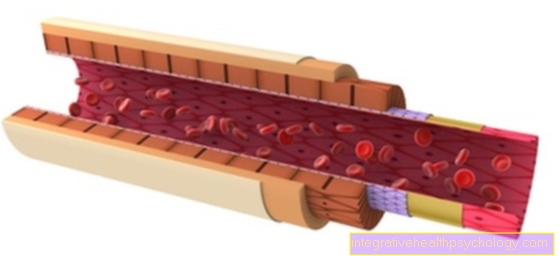Radiation for prostate cancer
introduction
Prostate cancer is the most common tumor in men. Fortunately, there are many different therapy options available these days. One of these options is radiation, which, if diagnosed early, can lead to complete healing of the patient. At an advanced stage, radiation can alleviate tumor-associated symptoms.
But there are also different approaches to irradiation. Different rays and different methods can be used.

What methods of radiation are there?
With classic radiation, percutaneous radiotherapy, the skin is irradiated from the outside. In the case of a locally limited tumor, radiation alone is usually sufficient. In the case of metastases, hormone therapy is also required.
In addition to percutaneous radiotherapy, brachytherapy is also available. In this case, the prostate is irradiated from the inside. For this purpose, a radioactive source is placed in the tissue. There are two methods of brachytherapy. In the first procedure, LDR seeds, radioactive emitters, are permanently implanted into the tissue. The rays that are emitted here are usually low (LDR = low dose rate). In the case of clearly localized tumors, recurrences are prevented and side effects are reduced, since only the cancer is irradiated. The other method, temporary HDR brachytherapy, enables the application of high-dose radiation (HDR = high dose rate). Most of the time, this method is used in addition to traditional irradiation to increase the effect.
There is also intensity-modulated radiotherapy (IMRT). It enables targeted irradiation, but the planning of this procedure is very complex.
Radionuclides can be used in patients at an advanced stage who are already suffering from bone metastases. These are given by infusion and accumulate in the bone. In this way, tumor-associated pain can be alleviated and the patient's quality of life can be improved.
Also read the article: What are the stages in prostate cancer?
How is the preparation for the irradiation?
An individual treatment plan is created for each patient. The goal of this treatment plan is the optimal irradiation of the tumor, whereas the surrounding tissue and the neighboring organs should be spared as possible. The preparation for this includes the analysis of previous examinations and the creation of a new CT.
The CT makes a lot of cross sections to determine the exact location of the tumor. In addition, the exact anatomy of the patient is recorded. With the help of this CT, medical physicists and radiation therapy specialists create a tailor-made plan. Then skin markings are applied to record the exact location. This marking should not be washed off as it will be needed in the further course of treatment.
After the plan has been drawn up, the first irradiation takes place. The irradiation fields are checked and made sure that they agree with the calculated data. Then the daily irradiation takes place.
With brachytherapy, on the other hand, an implantation plan is created using additional software. This determines the exact location of the radiation sources.
The course of the irradiation
After extensive preparation, the actual irradiation can begin. With percutaneous irradiation, the patient lies down on a couch that is located below the linear accelerator. The device rotates around the bed and emits the radiation. The radiation that is emitted here is around 1.8-2.0 Gray. At the end of the treatment, 74-80 Gray should have been delivered. The total dose is distributed because a single exposure with the total dose would damage the surrounding tissue too much.
In brachytherapy, irradiation takes place through implanted radioactive sources. In order to bring the sources into the tissue, anesthesia or local anesthesia is necessary.For LDR brachytherapy, a catheter is first inserted into the urinary bladder. Then contrast agent is introduced so that the urethra can be seen on the ultrasound or X-ray image. This ensures that the urethra is not injured during the procedure. Tiny radioactive metal particles are then inserted into the prostate via fine hollow needles. The hollow needles are then removed and a follow-up check is carried out after about a month.
The process of HDR brachytherapy is similar. In this case, the radiation sources are not left in the tissue, but are removed immediately after the irradiation. In addition, the radiation source is much stronger than with LDR brachytherapy.
The duration of exposure
Depending on the stage of the tumor, you will be irradiated for seven to nine weeks. The irradiation takes place on working days, the weekend is used to regenerate the tissue. The treatment plan can, however, be designed differently.
The radiation itself is very short, it lasts a few minutes.
How often do I have to have radiation?
Most patients receive radiation for seven to nine weeks and need radiation every day during the week. So you can count on 35-45 appointments for the radiation. However, the treatment appointments can vary considerably from person to person, which is why it makes sense to discuss further details with your doctor.
Is that possible on an outpatient basis?
With percutaneous radiotherapy and LDR brachytherapy, you can go home immediately after the treatment. HDR brachytherapy, on the other hand, requires hospitalization for several days.
Whether the treatment with radionuclides can be carried out on an outpatient basis depends on the drug. It is best to discuss this with your doctor.
Also read the article: Metastases in prostate cancer.
The side effects of radiation
The side effects of radiation can be divided into two categories: the acute and the long-term side effects.
Acute side effects include skin irritation, which can lead to a rash and itching. Furthermore, the urethra or the bladder can become inflamed. The symptoms are similar to those of a cystitis. In addition, the intestinal lining can become inflamed, which can lead to diarrhea.
Long-term side effects of radiation are incontinence, diarrhea and impotence.
Read more on the subject at: Side effects of radiation
The urge to urinate as a side effect
The urge to urinate is a known side effect of radiation. The irradiation causes the mucous membrane of the urethra and the urinary bladder to become inflamed. This inflammation is usually acute, but it can become chronic and narrow the urethra. In addition to the urge to urinate, symptoms such as pain and possibly blood in the urine may occur. Incontinence is also possible.
Painkillers are used for treatment and, in some cases, antibiotics are used to prevent infection. In this case, it is also advisable to drink a lot.
The diarrhea as a side effect
Diarrhea is also one of the more common side effects. The radiation leads to inflammation of the mucous membrane. As a result, diarrhea, pain and possibly light bleeding occur.
Various drugs can be used for treatment.
Read the article: Medication for diarrhea.
What are the long-term effects of radiation?
The irradiation initially leads to an acute inflammatory reaction in the surrounding tissue. However, the inflammation can become chronic over time and lead to permanent change. This can lead to chronic intestinal problems. Medicines are available to reduce diarrhea and pain.
In addition to the intestinal complaints, incontinence is also possible. The radiation can weaken the sphincter muscles. During physical exertion or when coughing, sneezing and laughing, urine may pass involuntarily. Through targeted therapy, urinary incontinence can be improved or even cured. For this reason, you should speak to your treating doctor at an early stage in order to search for a suitable therapy.
- Find out more about the Long-term effects after radiation treatment.
Another long-term consequence of radiation is erectile dysfunction. The risk of erectile dysfunction after radiation therapy is lower than after surgery, but it is still there. There are various drug and mechanical therapy options available.
Find out all about the topic here: The therapy of erectile dysfunction.
What are the alternatives to radiation?
There are several treatment options available. However, these depend on the stage of the cancer. For this reason, you should decide together with your doctor which therapy makes the most sense for you.
In the case of locally limited tumors that show slow growth, one can wait and only observe the tumor. The patient has to go to regular check-ups in order to recognize progress as early as possible. This procedure is called Active Surveillance. This is to avoid unnecessary side effects that can result from therapy.
If the tumor is growing rapidly but there are no metastases, surgery can be performed as an alternative to radiation. Nevertheless, radiation therapy may be necessary after the operation. This depends on whether the tumor has been completely removed (so-called R0 resection).
Hormone therapy is used for a metastatic tumor. Usually this is administered in combination with a chemotherapeutic agent to increase the effectiveness.
Find out more about this topic here: Treatment of prostate cancer.





























